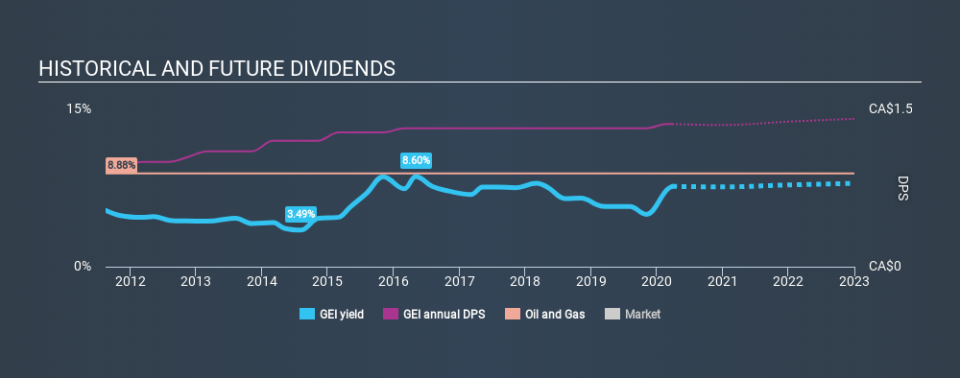We Wouldn't Be Too Quick To Buy Gibson Energy Inc. (TSE:GEI) Before It Goes Ex-Dividend

Some investors rely on dividends for growing their wealth, and if you're one of those dividend sleuths, you might be intrigued to know that Gibson Energy Inc. (TSE:GEI) is about to go ex-dividend in just 3 days. If you purchase the stock on or after the 30th of March, you won't be eligible to receive this dividend, when it is paid on the 17th of April.
Gibson Energy's upcoming dividend is CA$0.34 a share, following on from the last 12 months, when the company distributed a total of CA$1.36 per share to shareholders. Last year's total dividend payments show that Gibson Energy has a trailing yield of 7.7% on the current share price of CA$17.75. If you buy this business for its dividend, you should have an idea of whether Gibson Energy's dividend is reliable and sustainable. That's why we should always check whether the dividend payments appear sustainable, and if the company is growing.
Check out our latest analysis for Gibson Energy
Dividends are usually paid out of company profits, so if a company pays out more than it earned then its dividend is usually at greater risk of being cut. Last year Gibson Energy paid out 109% of its profits as dividends to shareholders, suggesting the dividend is not well covered by earnings. That said, even highly profitable companies sometimes might not generate enough cash to pay the dividend, which is why we should always check if the dividend is covered by cash flow. Gibson Energy paid out more free cash flow than it generated - 197%, to be precise - last year, which we think is concerningly high. We're curious about why the company paid out more cash than it generated last year, since this can be one of the early signs that a dividend may be unsustainable.
Cash is slightly more important than profit from a dividend perspective, but given Gibson Energy's payments were not well covered by either earnings or cash flow, we are concerned about the sustainability of this dividend.
Click here to see the company's payout ratio, plus analyst estimates of its future dividends.
Have Earnings And Dividends Been Growing?
Businesses with strong growth prospects usually make the best dividend payers, because it's easier to grow dividends when earnings per share are improving. If business enters a downturn and the dividend is cut, the company could see its value fall precipitously. Fortunately for readers, Gibson Energy's earnings per share have been growing at 10% a year for the past five years. It's not encouraging to see Gibson Energy paying out basically all of its earnings and cashflow to shareholders. We're glad that earnings are growing rapidly, but we're wary of the company stretching itself financially.
Many investors will assess a company's dividend performance by evaluating how much the dividend payments have changed over time. Gibson Energy has delivered an average of 3.9% per year annual increase in its dividend, based on the past nine years of dividend payments. It's good to see both earnings and the dividend have improved - although the former has been rising much quicker than the latter, possibly due to the company reinvesting more of its profits in growth.
The Bottom Line
Is Gibson Energy an attractive dividend stock, or better left on the shelf? While it's nice to see earnings per share growing, we're curious about how Gibson Energy intends to continue growing, or maintain the dividend in a downturn given that it's paying out such a high percentage of its earnings and cashflow. Bottom line: Gibson Energy has some unfortunate characteristics that we think could lead to sub-optimal outcomes for dividend investors.
So if you're still interested in Gibson Energy despite it's poor dividend qualities, you should be well informed on some of the risks facing this stock. Be aware that Gibson Energy is showing 3 warning signs in our investment analysis, and 1 of those doesn't sit too well with us...
A common investment mistake is buying the first interesting stock you see. Here you can find a list of promising dividend stocks with a greater than 2% yield and an upcoming dividend.
If you spot an error that warrants correction, please contact the editor at editorial-team@simplywallst.com. This article by Simply Wall St is general in nature. It does not constitute a recommendation to buy or sell any stock, and does not take account of your objectives, or your financial situation. Simply Wall St has no position in the stocks mentioned.
We aim to bring you long-term focused research analysis driven by fundamental data. Note that our analysis may not factor in the latest price-sensitive company announcements or qualitative material. Thank you for reading.

 Yahoo Finance
Yahoo Finance 
